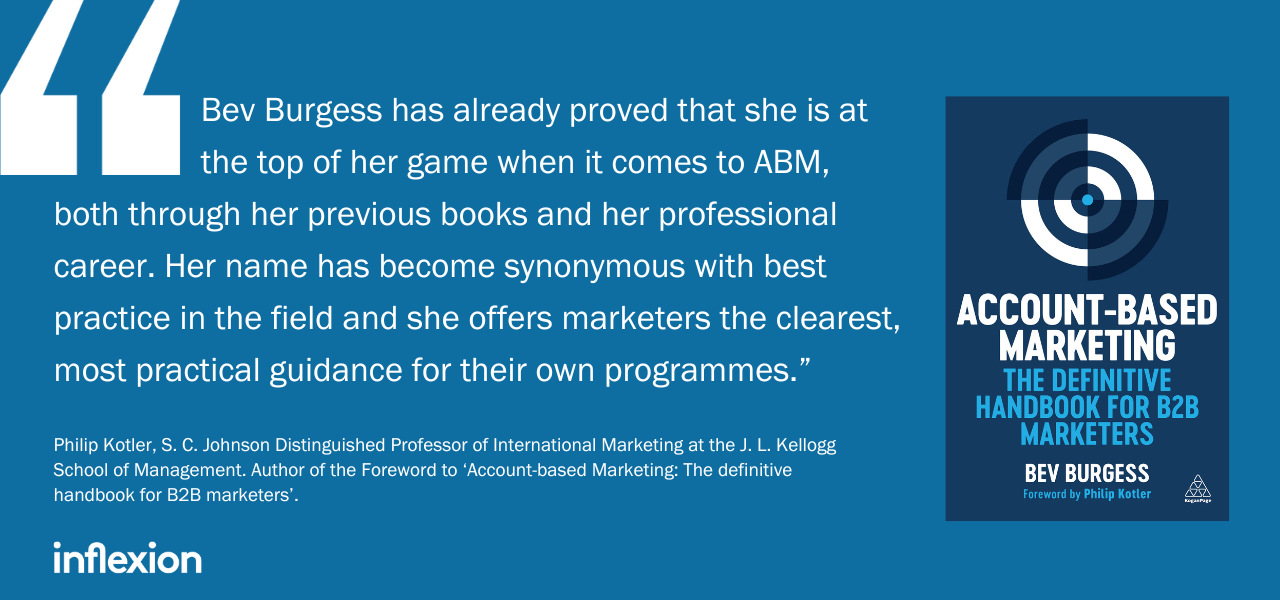Since account-based marketing (ABM) was codified as a marketing approach in 2003, it has reshaped the way we think about B2B marketing. We are now at the point where the majority of B2B companies are at least exploring how to pivot to an ABM approach for their priority customers and prospects, and many have already made significant investments in their ABM programmes. My new book is designed to be a handbook for B2B marketers who are learning about ABM for the first time, as well as for experienced ABM-ers who want to keep up with the latest advances in the practice. I hope it will also help anyone running global programmes to enable their colleagues to use ABM to build relationships, strengthen reputation and accelerate growth with key accounts.
Much has changed since the early experimental days of ABM, where the end-to-end marketing management process was applied to a single strategic account to drive sustainable growth. ABM is now widely recognised as delivering a greater ROI than any other type of B2B marketing, hence the reason it has been so widely adopted.
Over the past twenty years, ABM has followed the classic ‘diffusion of innovation’ curve that most new business ideas go through. Much of this diffusion is due to the software sector that supports an ABM approach. Companies like Demandbase, 6sense and Terminus have invested in educating the market and spreading the word, as have respected analyst firms such as Gartner and Forrester. Amazingly, the ABM software market was worth USD $1.3bn in 2022 and is expected to expand at a CAGR of 15.33%, reaching USD $3.1bn by 2028.
Yet, while much has been written about ABM around the world, there remains a lack of standardisation as to what it is — and isn’t — how to design the right approach for specific businesses to align with account management, sales and delivery processes, and how to flex that approach for customers in different industry sectors and cultures. The academic world has been slow to catch up with marketing practitioners in this field, with relatively few doctoral research projects in this area, although that is now changing and ABM is increasingly taught on marketing and business courses.
There is no doubt that ABM is advancing, both in terms of the way it is done and the extent of its activation in B2B marketing functions. Some companies have already switched whole field and industry marketing teams to an ABM focus, with the result that there are more and more B2B marketers that need help understanding how to deliver results with this targeted approach.
With all of this in mind, I wanted to write a new book to define ABM, exploring its evolution and the way it is reshaping B2B marketing. Account-Based Marketing examines ABM from the perspective of both the business and its customers before going on to explain:
- How to design the right ABM strategy for your business
- The five types of ABM to consider as part of your strategy and how to decide which customers and prospects get which type
- How to do each type of ABM — Strategic, Scenario, Segment, Programmatic and Pursuit Marketing — including the step-by-step process and main considerations for each
- How to build your company’s ABM capability
- What the future of ABM might look like
No book on ABM could ignore the fact that AI is changing the way we do marketing, and you’ll find numerous references to where AI and generative AI can be used throughout the ABM process. That said, I did not used generative AI to write the book; it was written the traditional (and long) way — as my family and friends can testify!
I have some personal highlights in this book. First, its Foreword, from the father of modern marketing, Philip Kotler, who is able to put ABM into the wider context of how marketing has developed since the 1950s and how it continues to evolve today. Second, the 14 interviews with business leaders who have experience in ABM, plus a further 11 real-world case studies that demonstrate how to achieve success. I’m so grateful to everyone who gave their time and perspectives. The lessons learned shared by everyone featured will hopefully save you time and money in advancing your own ABM programme.
I sincerely hope that my new book will be a valuable resource for marketers everywhere. It replaces my previous book on the subject — A Practitioner’s Guide to ABM (Kogan Page, 2021, 2017) — the majority of which was written in 2016 and last updated in 2020 during the pandemic. The world has changed since then. It’s time for a new book that sets out how ABM is advancing, both in terms its evolution as a business practice and how it is influencing the wider B2B marketing domain.
To secure your copy, visit Kogan Page or Amazon.




